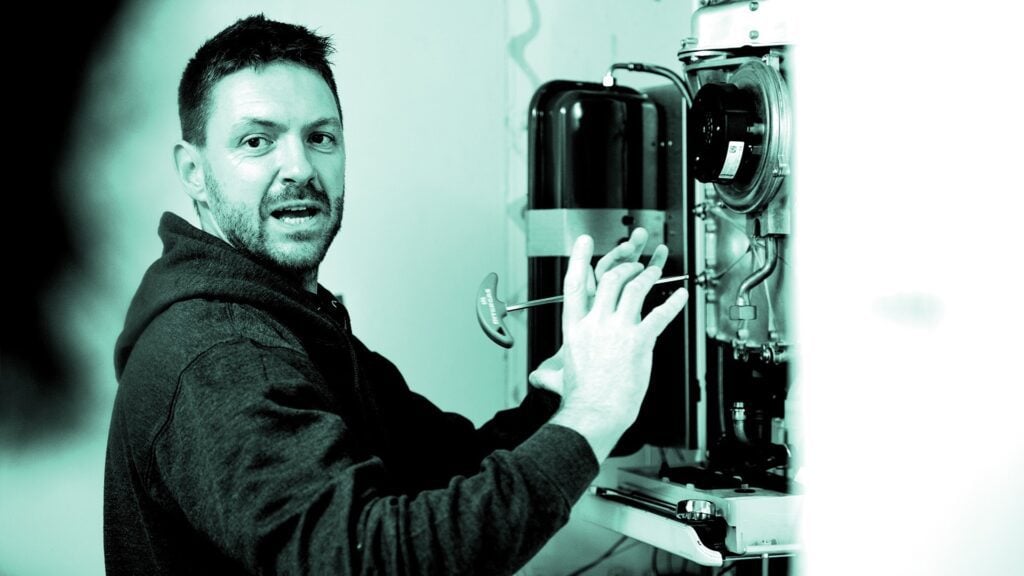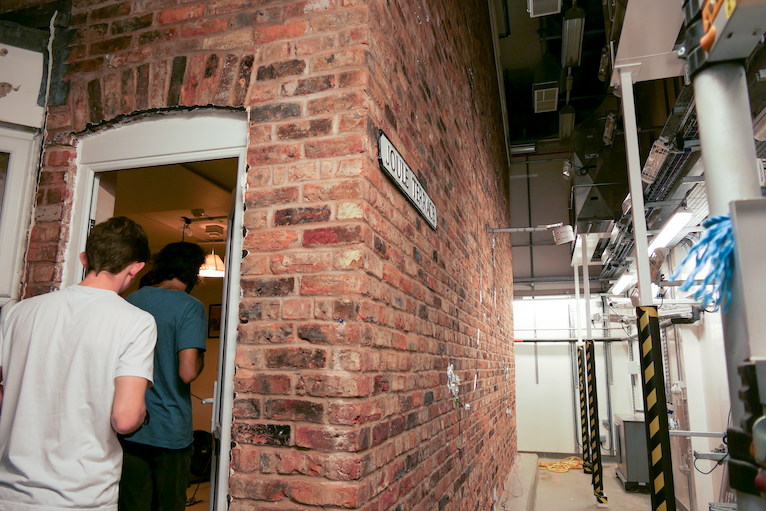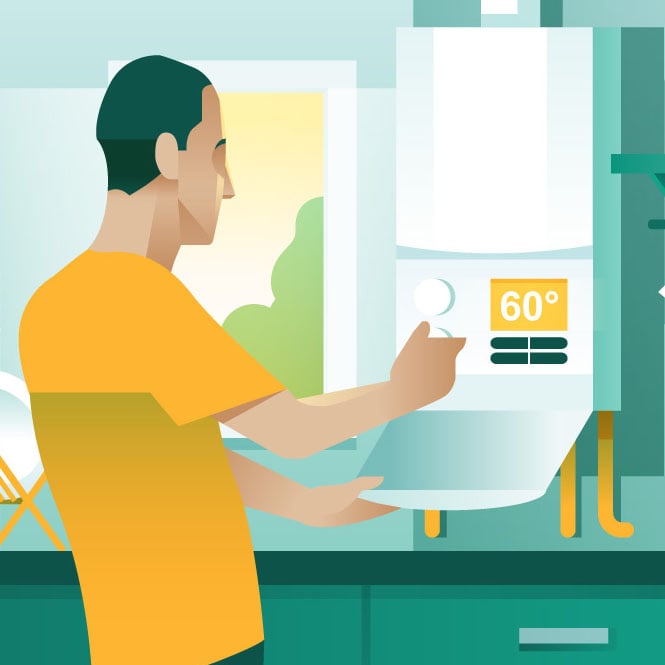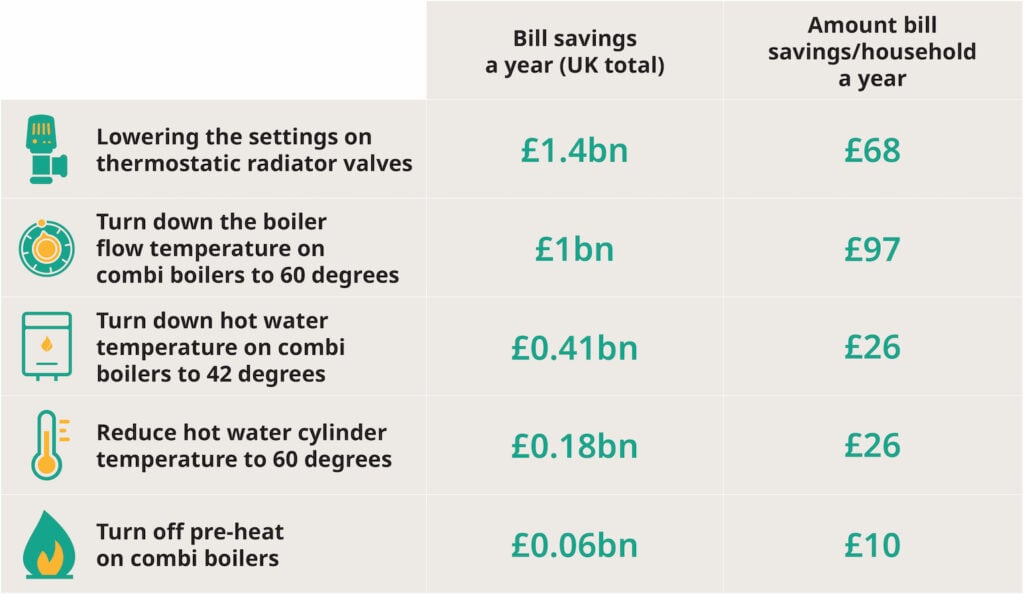House call: how we used a testing lab in Salford to identify the effects of changing boiler flow temperatures

21 December 2022
As part of Nesta’s mission to decarbonise home heating in the UK, we’re investigating the barriers to, and impacts of, households lowering the flow temperature of their condensing combi boilers – the temperature to which boilers heat the water that gets sent to our radiators.
One of the barriers to households lowering their boiler flow temperature was not knowing if changing their boiler settings would save them money. We wanted to find a way to measure the impact that changing boiler flow temperature could have in a real “home” environment. Enter The Energy House. From the outside, The Energy House at the University of Salford more closely resembles an industrial warehouse. Once inside however, you’ll find a state-of-the-art research and testing laboratory. Within an environmental chamber in the lab is a replica of an early 20th-century terraced house.

Complete with solid brick walls, suspended timber floors and single-glazed windows, the replica is a traditionally built, two-bedroom house with a conventional “wet” central heating system fired by a gas boiler.
Throughout the chamber and the house there are over 200 monitoring points with real-time data collection of temperature, humidity, heat flux, electricity and gas consumption. Testing in this environment allows for accurate and rapid assessment, making it ideal to simulate the effects of turning your boiler flow temperature up or down on a home that would be familiar to many of us living in the UK.

Our research at The Energy House measured the impact of reducing the flow temperature of a domestic gas condensing combi boiler at whole-house level, under controlled conditions. We set the thermostat to 21°C in the living room and adjusted thermostatic radiator valves to limit the temperature to roughly 18°C in all other rooms. We then varied the boiler flow temperature between 80°C and 50°C to assess the difference in gas use at different temperatures.
Not only could we test the impact that boiler temperature may have in standard conditions, but within the environmental chamber we could simulate a range of weather and temperature conditions, from wind, rain and snow to sun. Thanks to the adjustable environment, we were able to conduct a series of tests with outdoor temperatures of 4.5°C, to simulate average UK winter temperatures.
The study found that reducing the boiler flow temperature from 80°C to 60°C used 12% less gas to heat the Energy House for the same amount of time. This was primarily due to improved boiler efficiency, rather than reductions in internal air temperature (although the house did take a few minutes longer to warm up in the morning and evening). Assuming that 75% of home gas consumption is used for space heating – and the remainder for hot water and cooking – this would translate to a 9% saving on overall gas bills.
The full findings of this research are set out in the Salford Energy House report. To read a summary of that and other evidence, see Money Saving Boiler Challenge: Supporting evidence.
Nesta’s Money Saving Boiler Challenge encourages households to lower the flow temperature on their condensing combi boilers to 60°C. You can use our simple step-by-step tool to make this change.

This step-by-step guide walks you through changing your boiler flow temperature
It’s quick, free and easy to do. It can be changed back instantly if necessary so there’s nothing to lose by trying it.
How to change your boiler settings more regularly to save more money

*These figures were correct when blog was published but latest figures can be found here.*
21 December 2022
Nesta’s Money Saving Boiler Challenge encourages households to lower the flow temperature on their condensing combi boilers to 60°C. You can use our simple step-by-step tool to make this change.
Most combi boilers are installed to a temperature of around 80°C. An average household could save up to £65 per year by adjusting the boiler flow settings to 60°C. However, you can save even more by going lower than 60°C.
Save money by changing your flow temperature more often
Whilst reducing your boiler to a 60°C flow temperature could reduce your gas usage by around 9%, you could save even more money by lowering the flow temperature to 55°C.
We investigated the impact of this on average household savings through our Energy House project. The lower your flow temperature is set to, the more you save. However, at lower temperatures you might find your rooms take too long to heat up or aren’t reaching the temperature set on the thermostat.
Salford Energy House tests – gas saved at different flow temperatures of the boiler
| Starting flow temperature | Reduced flow temperature | Percentage saving on gas used for heating only | Overall gas saving, assuming heating accounts for 75% of total gas use |
| 80°C | 70°C | 5% | 3.9% |
| 80°C | 60°C | 12% | 9.1% |
| 80°C | 55°C | 16% | 12.1% |
| 80°C | 50°C | 23% | 17.4% |
A 12% gas saving could equate to around £150 off the average annual gas bill. It’s worth noting that some poorly insulated households may find that 55°C radiators are too cool for their home when it’s very cold outside. However, the radiators will still heat a room, it just may take a little more time and may not reach the temperature the thermostat is set to.
In warmer months, you can make bigger savings by lowering your flow temperature even further, like down to 50°C. In this way, you could adapt to the seasons and the weather outside by regularly changing your flow temperature settings. It’s safe and easy to change your boiler flow temperature settings multiple times over the year. The dials and buttons on the front of your boiler are there for you to use, you won’t damage your boiler by using these dials or buttons.
The best way to work out what flow temperature works for you in different seasons is to try reducing the flow temperature in 5°C increments. You could set your flow temperature to 50°C in October, raise it to 55°C in November and then raise it up to 60°C on the coldest days of the year. This way you are making bigger savings on the warmer days. Leave it at this new setting for a few days and see if you are happy with the temperatures of the rooms in your house. You can keep doing this until you find a temperature that works for you and your home.
There’s technology that can make the change for you!
If you have a modern “modulating” boiler, you can get a heating engineer to install a device that will automatically adjust your flow temperature. Two such technologies exist – called load compensation or weather compensation. Both will save energy in a similar way to reducing the flow temperature manually. These devices ensure that you are using a lower flow temperature when possible – without you needing to manually make any changes to your settings.
For details on how to turn down the flow temperature on your boiler, you can use our simple step-by-step tool.
Figures correct as at December 2022. Please note the views and advice in this blog post are provided by Nesta and are not attributable to partners of the Money Saving Boiler Campaign.

This step-by-step guide walks you through changing your boiler flow temperature
It’s quick, free and easy to do. It can be changed back instantly if necessary so there’s nothing to lose by trying it.
Free and easy ways to reduce your household gas use

*These figures were correct when blog was published but latest figures can be found here.*
21 December 2022
With the average energy bill now costing around £2,500, we’re all looking for ways to lower our energy bills.
There is a lot of advice out there, here are some evidence-based ways you can lower energy use and reduce carbon emissions from your home.
Top five free ways to save gas at home

1. Lower the settings on thermostatic radiator valves
Average households would save £68 a year off a typical gas bill by readjusting their thermostatic radiator valves down by 1.5°C.
Thermostatic radiator valves (TRVs) are self-regulating valves fitted to radiators that control the temperature of a room by changing the flow of hot water to the radiator.
TRVs are widely misused as on/off switches. Instead, they should be set to lower temperatures in rooms such as bedrooms and non-living areas to achieve maximum savings.
How do I do this?
Each TRV has a dial, usually numbered from 1 to 5 or 6. Where TRVs are currently set to 4 or above, we recommend turning the dial to the midpoint on all radiators outside the living room (eg, 3 on a dial up to 6). Higher settings will heat the room to over 18°C, which uses up more energy.
2. Turn down the boiler flow temperature on combi boilers to 60°C
Lowering a combi boiler flow temperature from 75°C to 60°C saves a typical household £97 a year (or 8% off the gas bill), if you are willing to accept slightly lower room temperatures.
The majority of UK homes have combi boilers (gas boilers that provide heating and hot water on demand, and don’t have a separate hot water tank). Many are currently set with a flow temperature – the temperature to which the boiler heats water that gets sent to the radiators – of 70-80°C. Lowering the flow temperature to 60°C or less makes the boiler run more efficiently.
How do I do this?
Nesta has created a simple online tool to help households make this change. Go to the Money Saving Boiler Challenge tool to take this action.
3. Turn down hot water temperature on combi boilers to 42°C
Turning down hot water temperatures on a combi boiler could save a typical household £26, or 2% off their gas bill per year.
Combi boilers also allow users to control the temperature of hot water supplied to taps and showers. Reducing the hot water temperature reduces the amount of fuel needed to heat the water. Even a couple of degrees will make a difference, and will not be a noticeable change.
How do I do this?
There should be a button or dial to change the hot water temperature on the front of your combi boiler – usually indicated by a little tap icon. If you’re not sure, check your boiler manual. We do not recommend lowering this below 42°C.
4. Reduce hot water cylinder temperature to 60°C
Setting your hot water cylinder to 60°C could cut 2% off a household’s gas use, or £26 off a typical gas bill, each year.
Homes that have heating systems with a separate hot water cylinder (instead of a combi boiler) can turn down the temperature of the cylinder itself so that water is not heated unnecessarily. The temperature should not be reduced below 60°C, as legionella bacteria, that can cause Legionnaires’ disease, can survive and grow in warm water stored below 60°C.
How do I do this?
You’ll usually find the control for your hot water cylinder ⅓ of the way up the tank. Here’s some more advice for efficient hot water cylinder heating. The temperature should not be reduced below 60°C, as legionella bacteria, that can cause Legionnaires’ disease, can survive and grow in warm water stored below 60°C.
5. Turn off pre-heat settings on combi boilers
Turning off the preheat setting could save households 0.8% or £10 off a typical gas bill per year.
Some combi boilers have a pre-heat setting that enables users to get hot water straight away, rather than waiting a few seconds for the taps to run hot. In order to do this, the boiler regularly fires up to heat a small amount of hot water, even when the taps are not in use. Turning off the pre-heat setting can help save households some energy at no extra cost.
How do I do this?
The Heating Hub has created some brilliant bespoke instructions for how to turn off this setting on different boiler types: Vaillant, Ideal and Worcester.
Have a little extra budget? Here are our top low-cost solutions to save on household gas
If you are able to invest up to £300 in some smart technology, a smart thermostat could save a typical household 5.3% (or up to £64) on their gas bill a year. Newer heating controls models, such as Nest version 3, have even smarter tech that can modulate compatible boilers (essentially turning down the flame in your boiler, similar to when you turn down the gas on your hob).
Installing loft insulation is certainly worth the hassle. For a detached house without a small amount of loft insulation, a DIY job topping up the insulation from 50-100m to 300 mm can cost around £200 and save £81 off a typical yearly gas bill.
To read more about these findings, you can read the full report on Nesta’s website.
Figures correct as at December 2022. Please note the views and advice in this blog post are provided by Nesta and are not attributable to partners of the Money Saving Boiler Campaign.

This step-by-step guide walks you through changing your boiler flow temperature
It’s quick, free and easy to do. It can be changed back instantly if necessary so there’s nothing to lose by trying it.

